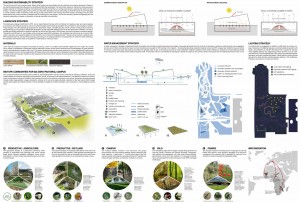LANDSCAPE STRATEGY
The landscape strategy transforms the EPFL into an Agro-Pastoral Campus which combines the meeting, study, and events spaces of a campus with productive, prairie, wild, and wetland biotope communities to reawaken the connection to pre-existing conditions. These biotopes fill in the platelets generated by the parametric model, strengthening the overall cohesion of the pavilion insertions and generating a living campus. Sustainable strategies include greywater cleansing and reuse and stormwater infiltration, the use of durable and locally produced or recycled materials, as well as low light levels, LED sources, and motion censors to conserve energy.
Through the combination of new biotope communities and sustainable strategies, the landscape can also serve as an area of interaction, discovery, and experimentation for both the EPFL community and the general public.
Biotope Communities for an Agro-Pastoral Campus
The proposed biotope communities aim to create an Agro-Pastoral EPFL Campus which combines the meeting, exhibition, study, and events spaces of a campus with agricultural production, prairie, wild nature, and wetland treatment. The addition of these new communities can provided a variety of benefits to the ecosystem as well as the students, professors, and visitors. Ecosystem services provided include carbon sequestration, oxygen production, removal of air, soil, and water pollutants, reduction of the heat island effect through cooling, food supply, and habitat creation. Human benefits of vegetation include inspiration, and a reduction in mental fatigue and sick days.
Design research developed within the framework of an invited competition by VWA in collaboration with Jef Huang and the Digital Media Lab, Summer 2012





